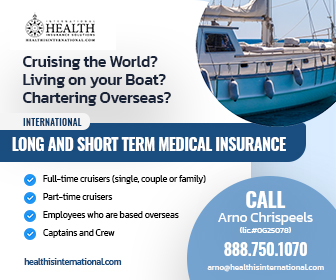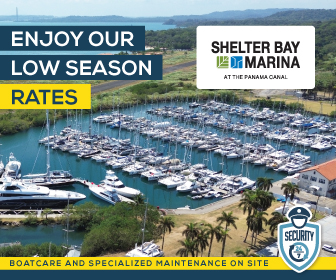Bahamas to Bermuda: Five days of Halyards, Lazybags and Windapps
Carla and Simon Fowler report on their eventful five day crossing from The Bahamas to Bermuda in April 2020 onboard their 40ft catamaran ‘Ocean Fox’.
Published 5 years ago
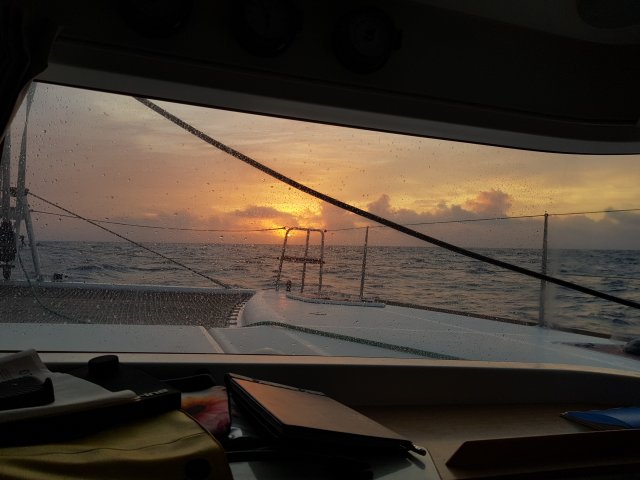

Carla and I had been scanning the wind applications for weeks looking for a weather window to take us the 735 nautical miles northeast into the small group of islands that make up Bermuda. Bermuda is a volcanic outcrop rising up from the seabed some 1,200 feet below. It is made up of twelve main islands and a further one hundred smaller ones. The six larger islands are linked together with bridges to make the so-called mainland. Hamilton is the capital and is hiding away in the center of the main island. The whole group is protected by a menacing coral reef that surrounds the islands, and this is all warmed from the gulf stream on its way across the Atlantic to Europe.
The weather is always a problem. The magic number is 23: With the wind at about this speed, we can sail at six to seven knots with no need for the engines. Below 18 and our speed drops below six knots, while anything above 28 knots and the seas start to build and make the ride uncomfortable. Ideally the wind has to come from the beam or beyond. Going to windward is challenging in a cruising cat.
We had also commissioned the help of a weather router. Charlie Carlow is an experienced sailor and offers a service to yachts making passages around the world. He advises us on the best route to take to manage the airflow across the sails and gives us a smooth and fast crossing. We have sought the experience of a professional weather forecaster before but never one that gave you a route to sail as well.
The cost was to be thirty pounds for the upfront research and route planning, then fifteen pounds a day for updates each of the five days of the crossing: A total of one hundred and five pounds. Wind apps could be costing you up to ninety pounds for a month with satellite downloads facilities that you will need at sea so the cost for the five days is quite comparable. We ended up using both Charlie and the wind app.
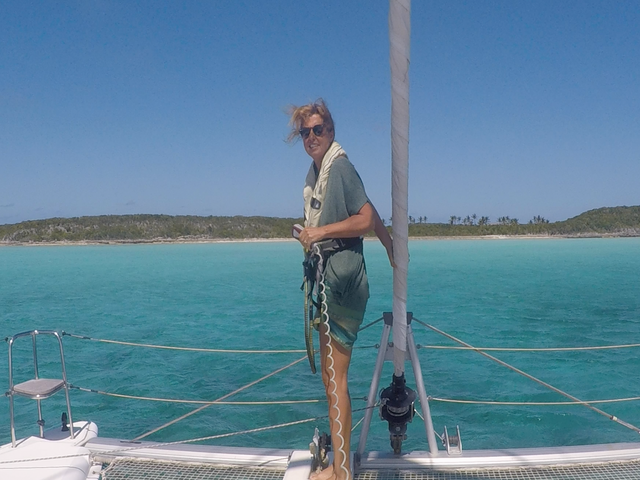

Day One – Departure from Abacos into a gale:
The morning had come for our departure. We lifted the anchor earlier than expected at 9:30 a.m. from the bay on the south side of Nunjack Cay in the Abacos Islands, The Bahamas. The date was April 23rd, which is still early in the season for the start of an Atlantic crossing.
We motored south through the Abacos Sea to the Two Rock Passage that would take us out into the Atlantic Ocean for the first time in nine weeks. We would soon be free from the shallow water of The Bahama Banks, free to let the sails take us on our way. The Cut through the reef was smooth with no breaking waves in the passage itself, but they were breaking on each side. If you get these Bahama’s cuts wrong, with tide and wind in opposite directions, they can become quite perilous.
It was now 10:30 a.m. and we could hoist the sails and lay a course to Bermuda on 070* magnetic. The wind as predicted would be 60 degrees off the nose – as close as we could sail to windward – becoming 90 degrees as the day moved on. After 10 minutes, we had traveled one mile, Carla got the rods out and we started to fish. 10 minutes later, Carla had the first bite that managed to escape the three-inch hook.
By midday I was bringing in the only fish we caught on the crossing. A good size male Mahi Mahi – a delicious eating fish that comes onboard with the most amazing vibrant colors of blue and yellow. This fish gave us enough food for a week.
By afternoon the wind was rising to over 30 knots, and with it, the seas were having their tops ripped off like a jet wash cutting through a puddle; it was all starting to get a little worrying. By now Carla was starting to get the first signs of seasickness, which would leave me alone to drive and monitor the boat. This is a problem that comes with having only two crew members on board. As daylight gave way to dusk and night fell, the pounding continued: It was going to be a long night.
At two in the morning the wind was blowing above 40 knots, and the code zero started to unfurl and we had over 100 square feet of light sailcloth ballooning out front. This was not going to be fun with the boat surfing down the waves at 11 knots – out on deck was not the place to be. I told Carla to get her life jacket on and we both went upstairs to fight the beast before us. As I clipped my lifeline on to the jack lines, the view was absolutely terrible. The deck lights were illuminating the huge red, orange, and yellow sail flogging itself to death against the backdrop of blackness; every now and then you could just see through the relentless spray.
Carla, who was clipped on and standing next to me, pulled the meters of halyard rope out of the bag, put two turns around the winch, and I released the rope clutch and the sail started to lower into the sea. Wrapped around the port bow and getting sucked under the boat, the acres of sail flogged and zipped around in the wind.
Just as I was going to go forward on to the pitching deck, Carla called me: The head of the sail was just outboard the main shroud and only barely in reach. With one hand on the coach grad rail I leaned out into the darkness with the foaming water below and grabbed the halyard. The two of us pulled the head of the sail on board and slowly worked our way forward, tying the canvas to the life rails as we went.
Thirty minutes later, we were back in the salon stripping off our wet clothes, shaking with adrenaline as we rested to allow our bodies to recover. None of this was ever on the cards – we are fair-weather sailors and plan only the best conditions, but we were being tested and this was by no means the first time. But the worst was yet to come.
We hammered on into the night, close to the wind. The wind speed was still increasing and we were making headway at seven to eight knots – velocity made good. Sitting on my own with just the glow of the plotter and the desk light, I scanned all the information to hand, Charlie’s predictions, the GRIB files to find some reason for this blow. But there was nothing, just a pleasant sail in 20 to 25 knots of wind.
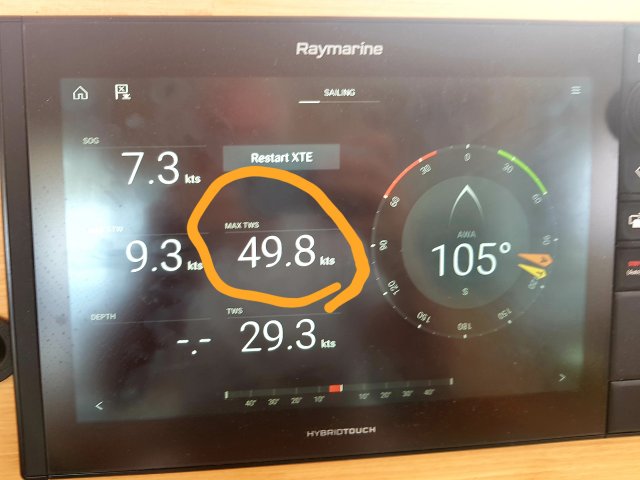

The wind indicator kept spinning north, hitting 52 knots apparent, 49.8 knots true: Storm 10, way past a gale on the Beaufort scale. I started to look at our options. We needed to turn to the northwest to get the wind behind us and reduce the stress on the boat and the two of us. Landfall would be Florida some 280 miles away – two days sailing. And without the correct visa a $500 fine on arrival.
I had run out of options. I made a course correction thirty degrees to port that would bring the wind, which had been veering by twenty degrees, around to aft of the beam. We were both up on deck again and dropped the mainsail and were now cruising along with fewer shakes and bumps on into the night. We were still covering the ground at six knots, but Bermuda was still far off to starboard of our course.
Day Two – Threat of Thunderstorms:
At first light the gale had passed and we were bobbing along at four knots with just the genoa providing the power. The seas were still upset and they would take a day to recover. At that moment, the mainsail had to go back up. With Carla still seasick, the two of us put our life vests on, opened the door, clipped ourselves to the boat, and went upstairs to the helm position. We started to sort through the mess of lines from the night before, which we had left in a pile, knotted like a bird’s nest on the cockpit floor.
During the early hours of the storm, the lazy bag lines on the port side parted and the mainsail started pouring out of the bag and over the deck. A makeshift repair was needed so we took the code zero halyard, wrapped it around the rear of the spreaders, and attached it to the lazylines. We then re-hoisted the bag and pulled the sail back in.
We started the engines, furled away the genoa, spun the boat 180 degrees and headed into the wind and the waves. Carla let out a scream as we pitched down one wave and into the trough at the bottom. The seven-foot-high bow buried itself into the next approaching wave. The spray was over the foredeck, through the air, and in our faces some 30 feet away. This reminded me of my monohull days, sailing in the English Channel.
I lifted the sail as best I could, hand winching the last three feet as Carla kept the Ocean Fox heading into the wind and swell. We bore away to port, set course to 70 degrees magnetic, unfurled the genoa, and killed the engines. We were sailing again and in the right direction, making six to eight knots, hour by hour.
Life returned to normal as the wind returned to an average of around 20 knots. There was a lot of banging, bridge deck slaps, and shaking as we surfed down the breaking waves, but we were safe inside. This was not a day for walking the “promenade” deck and taking in the fresh Atlantic air.
I received an email from Charlie asking us to change course to starboard by 20 degrees and head for a waypoint in the middle of nowhere. This would stop us going past the latitude of 20.40’ north. If we passed that point we had the possibility of straying across a line of thunder cells making their way south from Florida.
By four in the afternoon the wind had dropped off, to maintain our six knots I started the starboard engine. I would run the starboard engine during the day and the port one at night. This way it would be quieter in our cabin to sleep. By running one engine at a time, we could make our 400 liters of fuel last 200 hours. That would give us a range of 1,200 nautical miles, meaning we had more than enough to get us to the next filling station in Bermuda.
In the evening, we had a hot meal for the first time. Carla had prepared all the food in advance so it was only a matter of heating the dish up in the oven. We settled into another night at sea, with Carla on watch from seven to 10 and again from one to four. I would do the midnight shift and the dawn watch, then grab another hour’s sleep before we let the day pass us by.
At 10 in the evening, we changed course again. Charlie had said the threat of thunderstorms will have passed and we should head northeast again regardless of our position east. As it happened, we did see flashes of lightning lighting up the night sky to the north of us during the evening.
Day Three – Motor Sailing:
From a sailing point of view, day three had little to offer. It was a mixture of being under sail and motor sailing depending on the wind strength. Carla was starting to feel better and that gave us hope that the worst of the weather was behind us, and we started to look forward to our arrival into Bermuda. We passed the middle-passage point at 10.37 a.m., from here we had 369.5 nautical miles to run on the rum line.
Charlie had been looking into our arrival – most importantly the final night at sea. There would be a cold wind coming down from the east coast of North America. He had asked us to stay south of the rum line and head for another waypoint in the middle of nowhere at 30.30’N 067.15’W. From there we would head straight to our destination arriving sometime on Tuesday morning, five days after our departure.
During the afternoon Carla was asleep down in the cabin and I was watching a video in the salon. All of a sudden there was a ping and the rattle of the mainsail coming down. I didn’t need to go on deck, I knew what had happened. The main halyard had parted just where the rope went into the sheave block at the top of the mast. For some reason it was rubbing against the plates that hold the blocks in place.
I let Carla sleep for an hour before we tackled the problem. In beautiful sunshine and deep blue waters the two of us went on deck. I went up on top of the coach roof and out to the end of the boom. From there I could disconnect the topping lift, which we would use this to pull the mainsail up. The boom would have to be supported by the lazybag, and the code zero halyard which we used the day before. Not terribly satisfactory but a trip up the mast in the North Atlantic was not on either of our bucket lists.
We went through the process of going head to wind to lift the mainsail, then setting course again to our waypoint. At least we were sailing and later in the day the wind did pipe up to the mid-twenties where we were able to kill the engines and let the boat do what it was designed for: cross the ocean without the use of fossil fuel.
We put a reef into the mainsail before dark, which would give us the genoa to play with should the wind increase. It would have to get to over 35 knots before we would have to come on deck in the dark to put a second reef in. But sometimes that is what we had to do. The rear reefing line did not work its way all the way through – a problem I often find with single line reefing. It is a big reef on this sail and you have a lot of rope to get through. We also never go head to wind; we lower the sail a foot then take in the reefing line four feet. We work our way slowly through the line until the reef is in place.
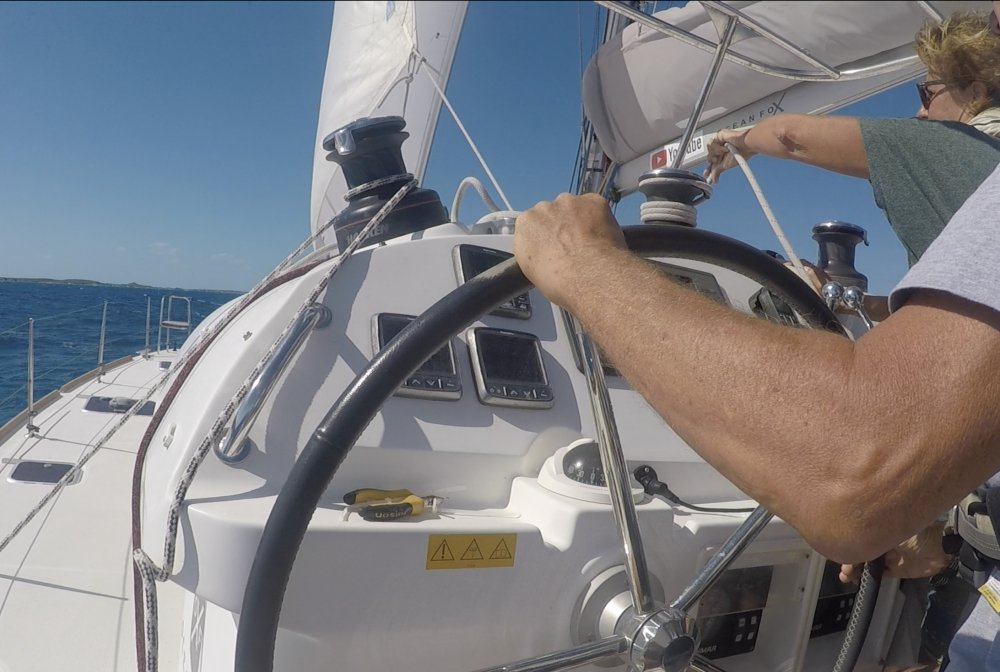

Day Four – Great Sailing:
As dawn broke at 5:05 a.m., a full ten minutes earlier than the day before and the day before that, I started to feel we were nearly there. We only had the last 24 hours or so to go. The sun was out, the breeze was up, and we were making ground at well over seven knots. This is when you know why you sail, why you put to sea, miles away from anywhere. In fact, we never saw another vessel during the whole trip. One wonders why we stay up all night looking into the darkness.
Around lunchtime, I peered up at the mast to see how things were coming along, and I could see the problem with the halyard. We have a square-topped mainsail and the upper section is secured to the mast car with a lazyline. This allows it to fold away from the mast and get stored in the bag when in port. The lazyline is Dyneema, an ultra-light rope that is stronger than a steel line. Somehow this had parted, allowing the sail to move away from the mast and coursing the chafe to the halyard.
Carla and I dropped the mainsail and I retied the halyard, giving us a new section for the wear and tear to take place. We tried to make a repair to the lazyline on the mainsail, but unfortunately this was unsuccessful and parted before the mainsail was fully raised. We would just have to run with it for the next 20 hours and hope it held.
Day Five – Arrival in Bermuda:
During the day the winds started to build. Charlie gave us our final instruction for crossing the front and heading to Saint George’s Harbour in Bermuda. This included the course to be sailed before, during, and after crossing the front – the time to gybe as the wind revolved around the rear of us. He also told us things not to worry about such as if we are not pointing towards our destination.
It all went incredibly well. With a little less than 65 nautical miles to run at 10:40 p.m., we crossed the line of the front. Carla and I were on deck to facilitate the gybe that took place with only 10 knots of wind. We did, however, have lashings of rain that managed to make its way through our coats and soak us to the skin. Having returned to the safety of the salon, I spent the next hour changing course to prevent us from gybing again. Charlie had said to take advantage of any north set, saying that as the wind increases it will start to turn to the east and take us down to Bermuda, so we didn’t need to worry about heading north for a few hours.
We followed the instructions to the letter and in the early hours of the morning at 4:20 a.m. I could see the 25-mile range: Saint Davids lighthouse flashing twice every twenty seconds. This was a welcoming site through the pitching seas. First light came early at 5:00 a.m. and from here we had a straight run to Gibbs Hill peninsular and then up the south coast of the island.
I called Bermuda Radio on channel 16 and a welcoming voice gave us instructions on where to go and what to do. Nothing was too much of a problem. If we needed anything we just had to let them know. We made our way through the channel, crabbing our way in with a 35-knot northerly wind blowing. As soon as we got into the cutting through the rocks the wind dropped and we were safe. We tied up on the customs dock at 9:30 a.m. local time. We had covered the 735 miles in four days and 22 hours. This was a little slower than we had hoped but we did have a few diversions along the way.
A successful passage:
The information and advice that Charlie sent us each day prepared us for what was about to happen, what to expect, and was invaluable for our successful passage making and greatly boosted our moral and safety at sea. Yes, he missed the 50 kts blow, but so did every weather app and every other forecast. It simply was not on the radar screen anywhere. But that is weather forecasting, more of an art than a science.
We will hopefully be making the next stage of our Atlantic crossing in June when we should expect to have more settled weather. But we will continue corresponding with Charlie to keep us on the right course and missing the highs and lows of the North Atlantic. For now we are sitting at anchor in quarantine for the next fourteen days and getting a well-needed rest.
Carla and Simon Fowler
SV Ocean Fox
Update: Carla and Simon did indeed cross the Atlantic and are now in the Azores.
……………………………………………………………………………………………………………………………………….
Related Links:
……………………………………………………………………………………………………………………………………….
The opinions expressed in this article are the author’s own and do not reflect the view of Noonsite.com or World Cruising Club.
Related to the following Cruising Resources: Atlantic Crossing, Caribbean Sea, Routing






